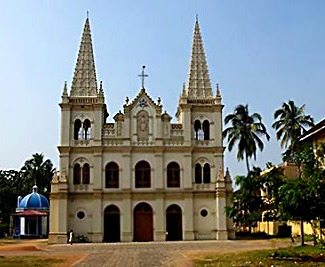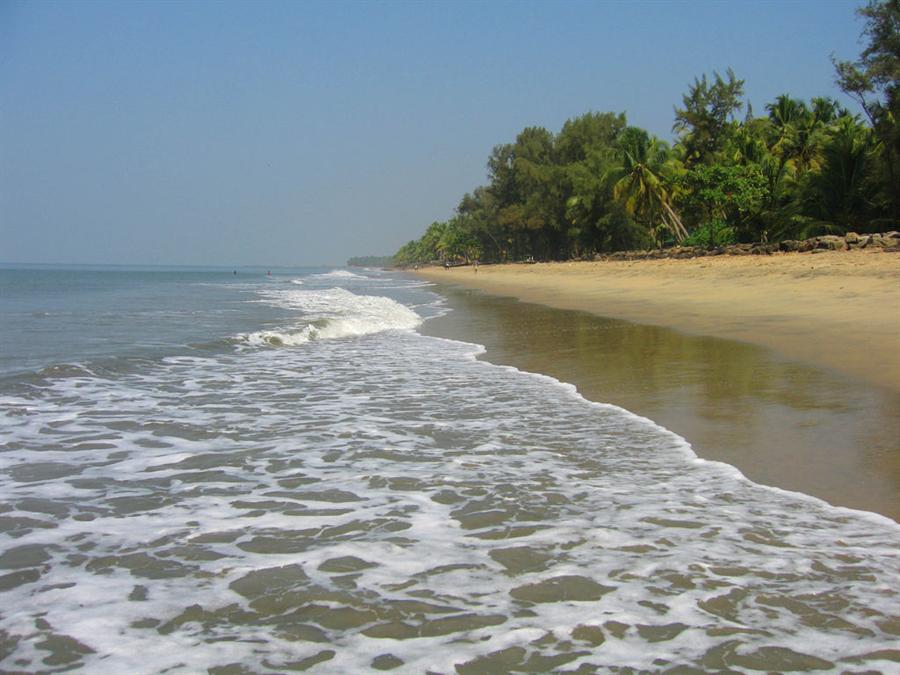Places to visit in Kochi
Kochi straddles the backwaters, encompassing the northern end of a peninsula, several islands and a portion of the mainland. To the west lies the Arabian Sea, and to the east is the urbanized region in the rest of the mainland area. Much of Kochi lies at sea level, with a coastline of 48 km.
Chinese Fishing Nets, Fort Kochi

Chinese traders from the court of Kublai Khan are believed to have introduced these huge cantilevered fishing nets in the late14th century. The nets are built of teak wood and bamboo poles. They can best be seen at sunset, on the north end of the promontory, a few metres from Fort Kochi, or from a boat tour of the harbour. Vasco da Gama square just behind the nets is an idle place to sit and savour the delicious seafood freshly caught in the nets, catered by the stalls here.
Fort Kochi beach

Fort Kochi. A historic beach where 1st Portuguese-Dutch war broke out in the 17th century. Once a very large beach, it has reduced to a quarter in size after the Tsunami. A beautiful, small walkway is constructed recently, making ideal for evening strolls. One can find remnants of Old Portuguese Immanuel Fort along with parts of Dutch Stormberg Fort with some canons still kept intact. An obsolete boiler that once used for powering cranes of old port and a very large anchor of an old Portuguese ship are displayed on the walkway. Works for creating a new artificial beach is undergoing near to this old beach with help of Tsunami development funds
St. Francis Church, Fort Kochi

It is the oldest church built by Europeans in India. On his 3rd visit to Kerala, Vasco da Gama, the Portuguese trader who reached India from Europe by sea, fell ill and died in Kochi. He was buried in the St. Francis Church. Later his remains were taken back to Portugal. In spite of that, his burial spot inside the church has been clearly marked out.
Vasco House, Fort Kochi

Built in 1503 by Portuguese Franciscan friars, this is India’s oldest European church. It was initially built of timber and later reconstructed in stone masonry. It was restored in 1779 by the Protestant Dutch, converted to an Anglican church by the British in 1795 and is at present governed by the Church of South India. Vasco da Gama was buried here in 1524 before his remains were moved to Lisbon, Portugal. The tombstone still remains.
Santa Cruz Basilica, Fort Kochi

The original church, situated in Fort Kochi, was built by the Portuguese in 1505 and named as a cathedral in 1558. The British colonists destroyed the cathedral in 1795. The current structure was built in 1905 and raised to the status of a basilica by Pope John Paul II in 1984.
Jewish Synagogue and Jew Town, Mattancherry


Also known as Pardesi Synagogue, the synagogue was built in 1568. Although it was demolished in a Portuguese raid in 1662, it was rebuilt two years later by the Dutch. It has stood the test of time, and is now handled and taken care of by Jewish families in Jew Town, Mattancherry. This Jewish temple houses many artifacts. The floor tiles are hand-painted Chinese ones from the 18th century. You can see scrolls, and there’s a 4th-century copper plate that bears the inscriptions of the Kochi Maharaja in ‘kannadiyezhuthu’ script in Malayalam. Its specialty is that it can be read only with the help of a mirror. The 19th-century glass chandeliers are from Belgium.
Dutch Palace (Mattancherry Palace), Mattancherry

The Mattancherry Palace, also known as Dutch Palace, stands overlooking Kochi backwaters, is situated at Palace Road, Mattancherry, 10km away from Kochi city. The unique importance of this monument is due to its mural paintings from the 16th century and dating up to 19th century.
Bolghatty Palace, Bolghatty Island

Bolgatty Palace is owned by KTDC, Kerala government’s tourism wing. It is a luxury heritage hotel located on the Bolghatty Island, off Kochi’s waters. The mansion was originally built by Dutch traders in 1744, and was leased to the British in 1909. It is the oldest of its kind that exists outside Holland. It served as the British residency till 1949.
Hill Palace, Tripunithura

Built in the 19th century by the Raja of Kochi, this palace served as the seat of the Raja of the Kochi province. The palace has been converted into a museum displaying a fine collection of articles showing the wealth and splendor of the Rajas of Kochi, including the thone and the crown. The museum also houses a large collection of archaeological findings. Hill Palace is located 16km east of Cochin in Tripunithura, a satellite town of Cochin.
Palliport (Pallipuram) Fort

One of the oldest existing European monuments in India, the Pallipuram Fort at Vypeen, an island near Cochin, was built by the Portuguese in 1503 and is the oldest surviving European fort in India. The Catholic Church at Pallipuram is an important pilgrim centre and attracts a lot tourist, too.
To reach the Pallipuram Fort, one can take a ferry service operating from Ernakulam boat jetty and Fort Kochi to Vypeen. There are buses also plying from Ernakulam to Vypeen and Vypeen to Pallipuram.
Mangalavanam Bird Sanctuary


Mangalavanam is a protected bird sanctuary situated right in the heart of Kochi city. It is the home of many exotic and rare varieties of migratory and resident birds. Mangalavanam is located right next to the High Court of Kerala.
Museum of Kerala History, Kalamassery

The museum has on display spectacular audio-visual exhibits depicting the history and culture of Kerala along with many life size statues of many famous personalities and several paintings depicting Kerala history.
Parikshith Thampuran Museum

Parikshith Thampuran Museum is an interesting place in the midst of hustle and bustle of city, is situated adjacent to Siva Temple at the Durbar Hall. This architectural museum will fascinate any visitor who is curious to know what the heritage of Kerala is all about. Parikshith Thampuran Museum exhibits objects that date back to the 19th century. It features old coins in a numismatic gallery, copies of mural paintings , copper and bronze sculptures, pre-historic monuments like megalithic relics, Kerala oil paintings, ancient monuments and scriptures made in stone and Plaster of Paris. Several memorabilia like arms and ammunition’s, personal possessions and antiques of the Kochi Royal Family are also kept in this museum.

Cherai Beach

The Cherai beach is the one-only in its kind that give an experience of Sea and the lagoon artfully separated by a narrow ground that landscaped by coconut palm. The 10 Km golden beach is fresh and ideal for swimming and sunbathing.
There are hundreds of accommodation facilities available in Cherai beach ranging from four star hotels and resorts to economy home stays. The local sea food restaurants, scattered all around are rich with verities of the Arabian Sea and outstanding fish delicacies of its own lagoon.
Best season to be there is November to May but one would like to experience the rainy monsoon the ideal period is June to October.
Best season to be there is November to May but one would like to experience the rainy monsoon the ideal period is June to October.
Veega Land

Veega Land is South India's largest amusement park situated 14kms from Cochin. The park includes a range of attractions including mini castles, water theme park, ferris wheel, rides, slides, shows and fountains. Kids and adults alike can enjoy the fun and activities.
Marine Drive


Walk by the breezy Marine Drive on summer nights and you will see the joy of visiting Cochin. Also called the Shanmugham Road, Marine Drive is indeed the heart of Cochin. Besides being the recreational area of the city, Marine Drive is also a significant economic center of Cochin. With bustling activities and increasing tourist interest the Marine Drive has become a major attraction in Cochin. This long winding road, facing the backwaters and lying by the seacoast of Cochin is a sight you shall remember all your life.Enjoy the sunrise that light up your existence and sunset that marks a new beginning with its brilliant splash of colors at the Marine Drive in Cochin. Your trip to Cochin will be incomplete without a visit to the Marine Drive.
Willingdon Island

Willingdon Island is a man-made island located in Kochi, Kerala, South India. The Island was created during construction of modern Kochi Port in 1936 with the soil dredged out while deepening the Vembanad Lake to accommodate the new Kochi Port. The idea of a new Island in Kochi, was first felt by Sir Robert Bristow, who was appointed by Lord Willingdon, then-the Governor of Madras Presidency for commissioning a new modern port in West coast of India at Kochi.It is an artificial island created from It's named after Lord Willingdon Robert Bristow, the chief protagonist and engineer for the project owned the first building on the island. Today the entire land belongs to Cochin Port Trust and Indian Navy. It is Now one of the Island which has access by Air,Road,Rail and Sea.
Jawaharlal Nehru Stadium, Kaloor

The Nehru stadium in Kaloor, has a seating capacity of 60,000 in multiple tiers. It is the fourth largest stadium in India and the largest in Kerala. The ground is lit by a set of unique convex pylon floodlights that arch over the ground. The stadium is home to both the Kerala Ranji cricket team as well as FC Kochi football team.



3 comments:
great post you have shared...gujarat The city where Mahatma Gandhi led several movements to attain Independence still continues to live by his morals and is thus an alcohol-free zone.
Gujarat tour package
Post a Comment